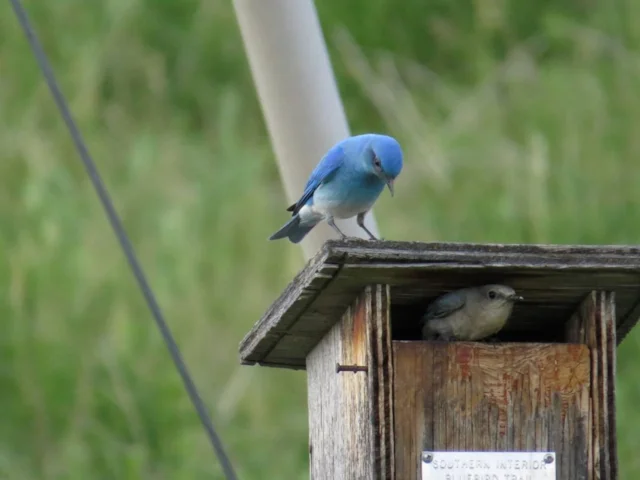Early arrival gives bluebirds an edge in keeping nest sites
a7c46e00-cb6e-4115-8c7a-7361ca6c9c99

Mountain Bluebirds are more likely to defend nest cavities from other birds if they get there first, but changes in migration timing may prevent this.
An established effect of climate change is the disruption of migratory timing, but a lesser -known follow-on from this is that hole-nesting birds may be less able to defend their territories owing to prior ownership being disturbed, according to new research in American ornithological journal The Auk.
The outcomes of interspecies battles for nest sites depend on a number of factors: while some species are inherently better competitors than others, the one that claims a site first also can have an advantage. To test what happens when Tree Swallows and Mountain Bluebirds compete for nest holes, Karen Wiebe of the University of Saskatchewan set up pairs of nest boxes side-by-side in grassland habitat in central British Columbia. When bluebird and swallow pairs moved in next door to each other, she would block the entrance to one box and let the two pairs of birds compete for the remaining one, or remove both boxes and replace them with a fresh one.
Wiebe found that when Tree Swallows were defending their previously owned box or when the two species were competing over a new box, the hirundines won 65-70 per cent of the time. Bluebirds got a boost when they defended a box they already occupied, however, fending off swallows 77 per cent of the time.
Mountain Bluebirds typically arrive on their breeding grounds earlier than Tree Swallows, giving them a chance to secure nesting locations before their competitors. However, climate change is moving up the timing of the swallows’ spring migration, which may bring the two species into direct competition more often and reduce the bluebirds’ abilities to claim and defend nest sites.
“I became interested in this topic after watching many competitive interactions over natural tree holes during a long-term study of Northern Flickers in central British Columbia,” says Wiebe. “In early spring, when the birds are trying to claim a nest site, these disputes can be intense and really grab your attention. Because bluebirds and swallows readily use nestboxes, I was motivated to try some experiments in a system where I could have more control over the spacing of nests and settlement patterns of the birds.”
“This is a nice set of clever and simple experiments that show that species are not the same when it comes to the importance of being the first one to occupy a nest site,” according to ecologist Hanna Kokko of the University of Zurich, an expert on interspecies competition in birds. “The one that currently tends to arrive first, the bluebird, relies more on this, which could easily cause problems if the arrival order changes on a changing planet.”
Reference
Wiebe, K L. 2016. Interspecific competition for nests: Prior ownership trumps resource holding potential for Mountain Bluebird competing with Tree Swallow. The Auk 133: 512-519.
An established effect of climate change is the disruption of migratory timing, but a lesser -known follow-on from this is that hole-nesting birds may be less able to defend their territories owing to prior ownership being disturbed, according to new research in American ornithological journal The Auk.
The outcomes of interspecies battles for nest sites depend on a number of factors: while some species are inherently better competitors than others, the one that claims a site first also can have an advantage. To test what happens when Tree Swallows and Mountain Bluebirds compete for nest holes, Karen Wiebe of the University of Saskatchewan set up pairs of nest boxes side-by-side in grassland habitat in central British Columbia. When bluebird and swallow pairs moved in next door to each other, she would block the entrance to one box and let the two pairs of birds compete for the remaining one, or remove both boxes and replace them with a fresh one.
Wiebe found that when Tree Swallows were defending their previously owned box or when the two species were competing over a new box, the hirundines won 65-70 per cent of the time. Bluebirds got a boost when they defended a box they already occupied, however, fending off swallows 77 per cent of the time.
Mountain Bluebirds typically arrive on their breeding grounds earlier than Tree Swallows, giving them a chance to secure nesting locations before their competitors. However, climate change is moving up the timing of the swallows’ spring migration, which may bring the two species into direct competition more often and reduce the bluebirds’ abilities to claim and defend nest sites.
“I became interested in this topic after watching many competitive interactions over natural tree holes during a long-term study of Northern Flickers in central British Columbia,” says Wiebe. “In early spring, when the birds are trying to claim a nest site, these disputes can be intense and really grab your attention. Because bluebirds and swallows readily use nestboxes, I was motivated to try some experiments in a system where I could have more control over the spacing of nests and settlement patterns of the birds.”
“This is a nice set of clever and simple experiments that show that species are not the same when it comes to the importance of being the first one to occupy a nest site,” according to ecologist Hanna Kokko of the University of Zurich, an expert on interspecies competition in birds. “The one that currently tends to arrive first, the bluebird, relies more on this, which could easily cause problems if the arrival order changes on a changing planet.”
Reference
Wiebe, K L. 2016. Interspecific competition for nests: Prior ownership trumps resource holding potential for Mountain Bluebird competing with Tree Swallow. The Auk 133: 512-519.

